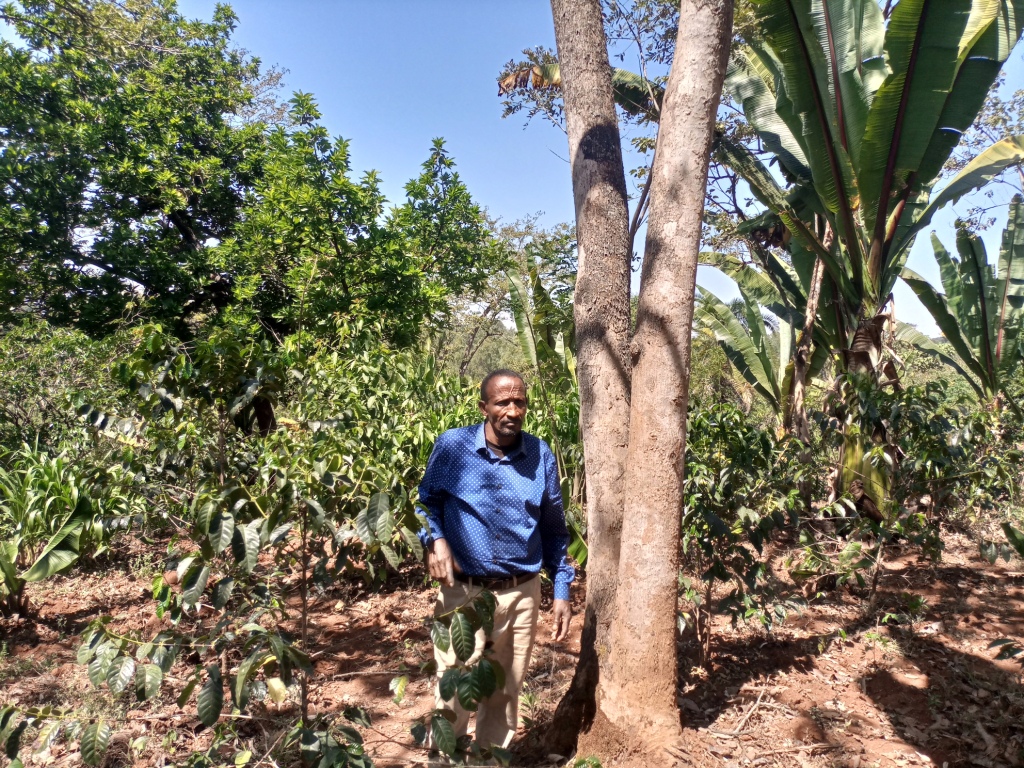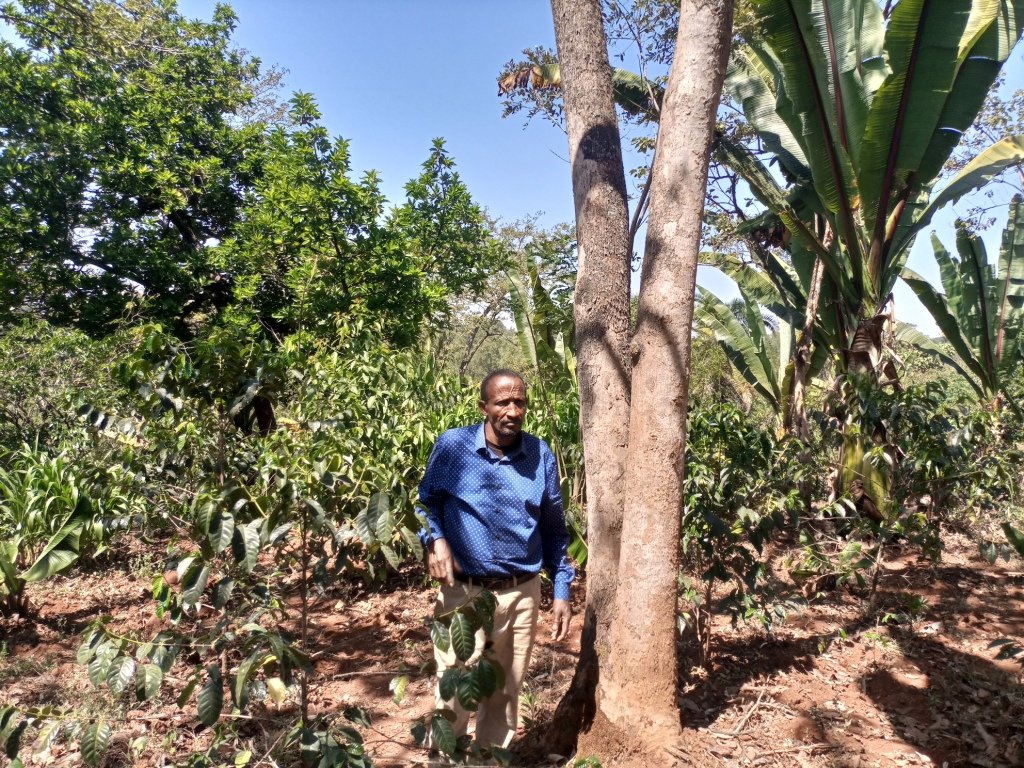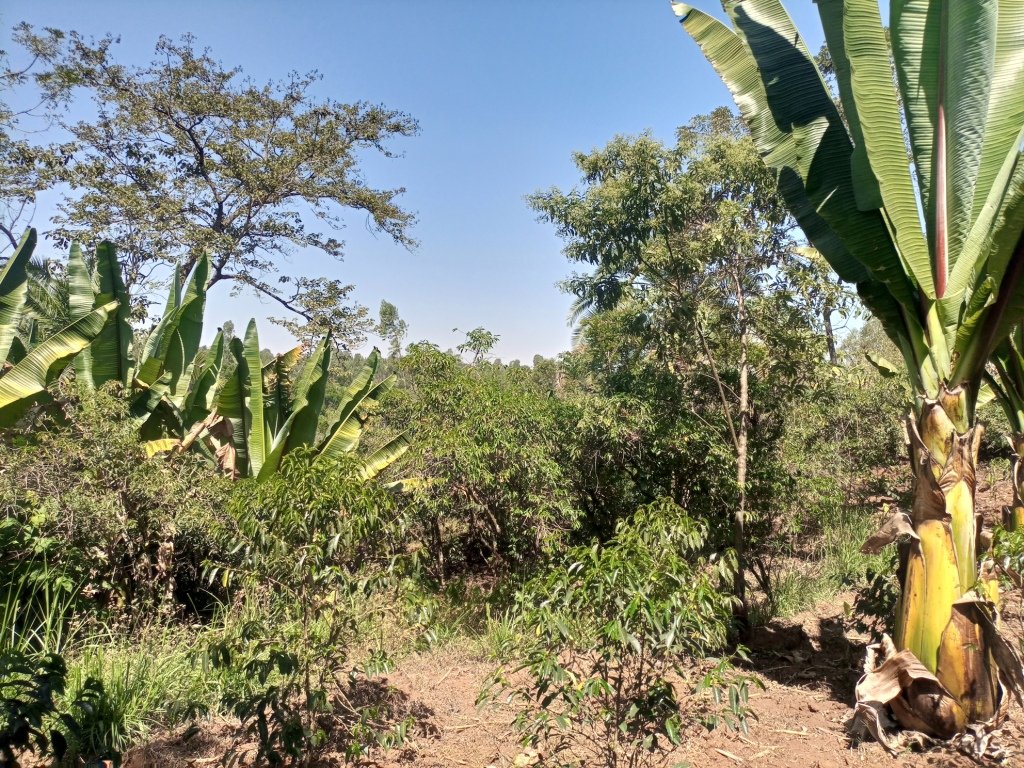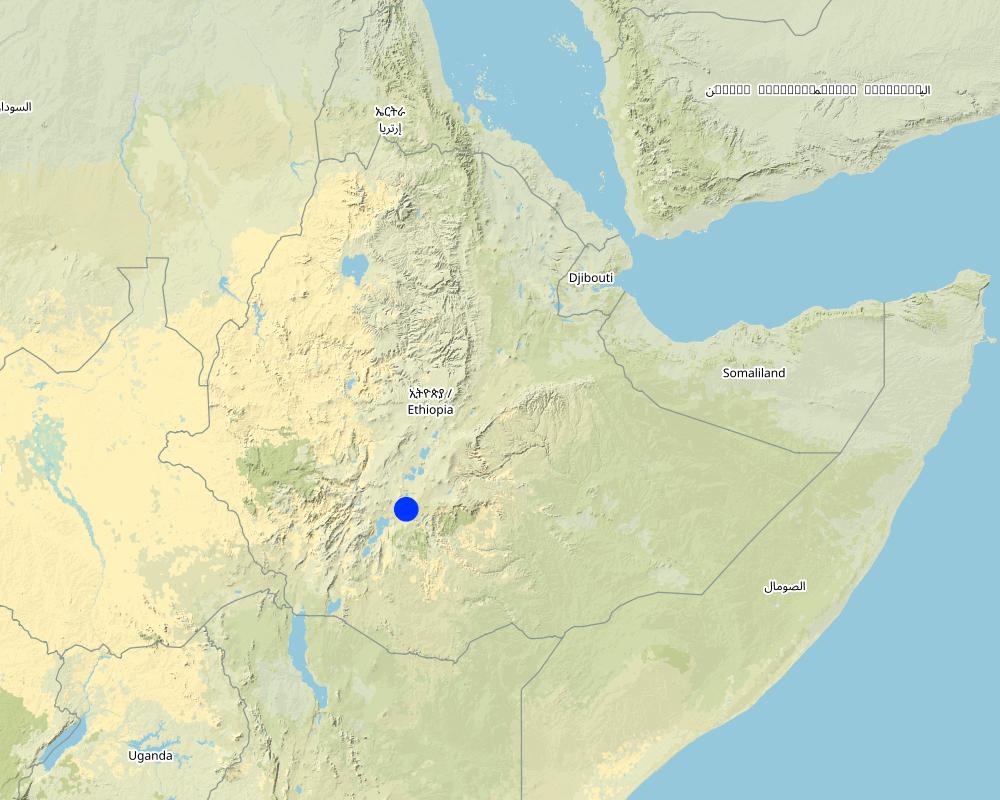Integrated Agroforestry System [埃塞俄比亚]
- 创建:
- 更新:
- 编制者: GERBA LETA
- 编辑者: Julia Doldt, Noel Templer, Kidist Yilma
- 审查者: William Critchley, Rima Mekdaschi Studer
Mitikarsamino Ersha
approaches_6622 - 埃塞俄比亚
查看章节
全部展开 全部收起1. 一般信息
1.2 参与方法评估和文件编制的资源人员和机构的联系方式
关键资源人员
土地使用者:
Gabiba Afra
+251 934 73 5738
Farmer
Dale District, Shoye kebele Sidma Regional State Ethiopia
埃塞俄比亚
有助于对方法进行记录/评估的项目名称(如相关)
Soil protection and rehabilitation for food security (ProSo(i)l)有助于对方法进行记录/评估的机构名称(如相关)
Alliance Bioversity and International Center for Tropical Agriculture (Alliance Bioversity-CIAT) - 肯尼亚1.3 关于使用通过WOCAT记录的数据的条件
(现场)数据是什么时候汇编的?:
13/01/2023
编制者和关键资源人员接受有关使用通过WOCAT记录数据的条件。:
是
1.4 SLM技术问卷的参考
2. SLM方法的描述
2.1 该方法的简要说明
The integrated agroforestry system is a self-initiated approach by a land user to implement agroforestry as part of an indigenous practice and has evolved over the years through technical support, training, and supplies of coffee and tree seedlings by the Office of Agriculture and Coffee Improvement Project. Had there been a participatory process throughout it would have helped in design and also in scaling up.
2.2 该方法的详细说明
该方法的详细说明:
The integrated agroforestry system was independently initiated by land users during the Derg regime (1974-91). During the regime, farmers were failed by two distinct and polar development approaches: socialist and the mainstream local approaches. The earlier one involved the communist approach of communal production and sharing the output according to contribution. The latter ones employed a conventional approach and included non-members of the so-called Farmers Producer Cooperatives. As a non-member of the earlier one, the land user had to develop his farm alone. The solitary agroforestry initiative described here has gradually evolved to a fully-fledged system that currently serves as a model SLM practice for scaling up across similar agroecological and farming system. Thus, there was little participation involved during the early intensification of agroforestry in Ethiopia. Rather, it is considered an indigenous practice that now receives publicity as a form of “regenerative agriculture” with ecological, economic, and social benefits. As it has global significance in terms of emission reduction and sequestration of carbon, it is the favourite technology among the government and other development practitioners.
The farmer started agroforestry by planting enset and coffee. Over time, with emerging technical support, access to training, and supply of coffee seedlings by the agriculture and coffee improvement project offices, the land user has continued intensification of the agroforestry around the homestead by adopting the correct planting space for coffee and enset, and other companion fruit, fodder crops, and shade trees. The former Ministry of Coffee and Tea, and the current Ministry of Agriculture have had an immense contribution by supplying technical support, training, and inputs (notably coffee and tree seedlings), and by ensuring access to fertilizers. The latter was supplied to the farmers on a credit basis through the then Service Cooperative.
As the initiative was the farmer's own, the tendency to plant incompatible crops was not uncommon. Even so, the agroforestry trees and shrubs still had immense ecological and economic value. They ameliorate the extreme temperature experienced during the dry season, improve the microclimate, recharge the surface and groundwater via improving water infiltration, and reduce runoff losses. Improving soil fertility and soil health are among other benefits. Despite the substantial benefit the technology confers on land users, the lack of a participatory approach in planning, implementation, monitoring, and evaluation at the community level restricts the adoption and scaling up of this beneficial approach. Despite the achievements of the land user, earlier engagement of other smallholders and institutionalizing the approach decades ago might have positively influenced the design as well as wider-scale adoption and application of the technology. However, regardless of any limitations, the technology is evidence-based and inspirational.
2.3 该方法的照片
关于照片的一般说明:
The photo shows the practice rather than the approach. However, the existing scene is just the outcome of the approach (farmer's own) employed to establish and maintain the agroforestry practice.
2.4 该方法的视频
注释、简短说明:
Videos of the approach is not documented.
2.5 采用该方法的国家/地区/地点
国家:
埃塞俄比亚
区域/州/省:
Sidama
有关地点的进一步说明:
Shoye kebele (Kebele - lower administrative level).
注释:
As perennial crop enset (false banana) is a staple food in the area, the farming system is tree based but vary with degrees of intensification.
Map
×2.6 该方法的开始和终止日期
注明开始年份:
1980
注释:
It is a continuous, non-ending self initiative inheritable by the generation to come.
2.7 方法的类型
- 传统/本土
2.8 该方法的主要目的/目标
A traditional approach was initiated to change the land use/ land cover and optimize the benefit of the degraded land by reducing the negative effects of overgrazing and its consequence.
2.9 推动或妨碍实施本办法所适用的技术的条件
社会/文化/宗教规范和价值观
- 启动
The long-standing tradition of the society promotes planting and preserving trees.
财务资源和服务的可用性/可得性
- 启动
Access to in-kind credit services such as fertilizers from farmers' cooperatives enables the land users to effectively implement the practice.
机构设置
- 阻碍
The lack of institutional setting might have influenced the rate of scaling the technology.
参与者的的协作/协调
- 启动
Foster farmers access to training, technical support, exchange visit...
法律框架(土地使用权、土地和水使用权)
- 启动
Enables the development of a sense of ownership and accountability to properly implement and manage the practice.
了解SLM,获得技术支持
- 启动
Promote effective implementation, management, and use of the return from the practice.
市场(购买投入,销售产品)和价格
- 启动
The availability of a fair and subsidized market enables the approach.
- 阻碍
Lack of reliable market compels to change the approach to another income-generating practice/approach.
工作量、人力资源可用性
- 启动
The availability of manpower enables one to accomplish the job without pressure.
- 阻碍
Shortage of manpower disables effective implementation of the practice.
3. 相关利益相关者的参与和角色
3.1 该方法涉及的利益相关者及其职责
- 当地土地使用者/当地社区
Land users and local communities
Plan and implement the technology, and sharing labor, skills and knowledge.
- SLM专家/农业顾问
Development agents (DAs) and district experts
Provide training, and technical support, facilitate land users' access to inputs such as seedlings and fertilizers, monitor and evaluate, and documentation of successful practices for pervasive application and use.
- 研究人员
Regional Agricultural Research Institute, and under/graduate students.
Generate supportive specific and relevant technologies, learn the lesson, and recommend best-fit technologies/practices.
- 地方政府
District administration and colleagues
Acknowledge the farmers/technology adopters as a model to showcase their experience and encourage the scaling out of the initiative.
3.2 当地土地使用者/当地社区参与该方法的不同阶段
| 当地土地使用者/当地社区的参与 | 指定参与人员并描述活动 | |
|---|---|---|
| 启动/动机 | 自我动员 | Land user: Initiated coffee and enset plantation little by little and accessed training and technical support from DAs and Woreda office of Agriculture experts. |
| 计划 | 自我动员 | Land user and development agent: In consultation with DAs, the land users plan based on available labor and capital every other year. |
| 实施 | 自我动员 | Land users and family member. They involved in various implementation/management activities. |
| 监测/评估 | 被动 | Government development agents, and experts coordinate mobilization of the communities to visit and learn from the ongoing practice. |
3.3 流程图(如可用)
具体说明:
A flow chart depicting the evolution of practice from self-initiative indigenous coffee planting practices to a multistorey agroforestry system with the participation and support of public organization agents and farmers' primary cooperative.
作者:
Gerba Leta
3.4 有关SLM技术选择的决策
具体说明谁有权决定选择要实施的技术:
- 仅限土地使用者(自主)
解释:
The land user was the initial decision maker that later cross-fertilized or complemented by research and development actors.
明确做出决策的依据:
- 个人经验和意见(无记录)
4. 技术支持、能力建设和知识管理
4.1 能力建设/培训
是否为土地使用者/其他利益相关者提供培训?:
是
明确受训人员:
- 土地使用者
- Development agents
如果相关,请说明性别、年龄、地位、种族等。:
Training is usually provided to literate farmers who are capable of reading, taking notes, and sharing with other peers back home. Women-headed household are inclusive to represent the gender parity.
培训形式:
- 公开会议
培训形式:
- Training and visit
涵盖的主题:
Coffee production and management such as preparation of planting pits, refilling the soil back to the pit, planting space, fertilizer application, weeding, mulching, planting shade trees, etc.
注释:
Integrating enset, shade trees, and soil bunds with productive barriers into the farm eventually evolves into the agroforestry system.
4.2 咨询服务
土地使用者有权使用咨询服务吗?:
是
指明是否提供了咨询服务:
- 在土地使用者的土地上
- 在固定中心
说明/注释:
The training used to be given in permanent centers such as development stations in the past and Farmers Training Center since recent a decade ago and was associated with a visit to a farmers field.
4.3 机构强化(组织发展)
是否通过这种方法建立或加强了机构?:
- 否
4.4 监测和评估
监测和评估是该方法的一部分吗?:
否
注释:
A sort of visit may be organized by development agents to the coffee plantation but not in a way address the role of monitoring and evaluation and documentation.
4.5 研究
研究是该方法的一部分吗?
否
5. 融资和外部物质支持
5.1 该方法中SLM组成部分的年度预算
如果不知道准确的年度预算,请给出一个范围:
- < 2,000
注释(例如主要的资助来源/主要捐助者):
Only in kind support such as coffee seedlings and technical support such as advisory service was provide by the government agricultural office through development/extension agents. Otherwise, it is privately financed business with main expense geared toward supplying seedlings and agricultural inputs such as fertilizers.
5.2 为土地使用者提供财政/物质支援
土地使用者是否获得实施该技术的财政/物质支持?:
是
如果是,请具体说明支持的类型、条件和提供者:
In the past (during Derg regime) there was subsidy for fertilizers as a country which is entirely removed in the recent years.
5.3 对特定投入的补贴(包括劳动力)
- 其它
| 其它(具体说明) | 程度如何 | 对补贴做出具体说明 |
|---|---|---|
| Fertilizer | 部分融资 | In the past, the government import and supply fertilizer on subsidized basis. The trend was changed over the last a couple of decades. |
如果土地使用者的劳动力是一项重要的投入,那么是不是:
- 自愿
注释:
Family labor used to manage the family farm.
5.4 信用
是否根据SLM活动的方法给予信用值?:
否
5.5 其它激励或手段
是否有其他激励措施或工具用于促进SLM技术的实施?:
否
6. 影响分析和结论性陈述
6.1 方法的影响
该方法是否有助于当地土地使用者,提高利益相关者的参与度?:
- 否
- 是,很少
- 是,中等
- 是,支持力度很大
The approach was mainly based on self initiative. The assistance that came in later on was top-down where farmers were urged to plant coffee and companion tree crops. However, later it has evolved into agroforestry and SLM that empower local land users to join.
这种方法是否有助于基于证据的决策?:
- 否
- 是,很少
- 是,中等
- 是,支持力度很大
It is not entirely the approach but the outcome of intensifying the technology that eventually enables land users and other stakeholders to make an evidence-based decision.
该方法是否帮助土地使用者实施和维护SLM技术?:
- 否
- 是,很少
- 是,中等
- 是,支持力度很大
The prevailing system compels farmers to integrate land management practices such as soil bunds, food and non-food tree species into the farm that enable land users to adopt and uphold SLM technology.
该方法是否提高了SLM的协调性和成本效益?:
- 否
- 是,很少
- 是,中等
- 是,支持力度很大
该方法是否调动/改善了使用财务资源实施SLM的途径?:
- 否
- 是,很少
- 是,中等
- 是,支持力度很大
,
该方法是否提高了土地使用者实施土地管理的知识和能力?:
- 否
- 是,很少
- 是,中等
- 是,支持力度很大
Through public meetings and social learning from peers and better-off farmers, land users' knowledge and skills to implement the technology have been improved.
该方法是否提高了其他利益相关者的知识和能力?:
- 否
- 是,很少
- 是,中等
- 是,支持力度很大
Virtually through social learning and labor sharing.
该方法是否建立/加强了机构、利益相关者之间的合作?:
- 否
- 是,很少
- 是,中等
- 是,支持力度很大
It was a solitary approach but later adopted by numerous land users.
该方法是否缓解了冲突?:
- 否
- 是,很少
- 是,中等
- 是,支持力度很大
该方法是否有助于社会和经济弱势群体?:
- 否
- 是,很少
- 是,中等
- 是,支持力度很大
It doesn't deliberate about gender disparity and equity as it was an indigenous initiative in the long past.
该方法是否改善了性别平等并赋予女性权力?:
- 否
- 是,很少
- 是,中等
- 是,支持力度很大
该方法是否鼓励年轻人/下一代土地使用者参与SLM?:
- 否
- 是,很少
- 是,中等
- 是,支持力度很大
The established technology built youths trust in SLM.
该方法是否改善了阻碍SLM技术实施的土地使用权/用户权问题?:
- 否
- 是,很少
- 是,中等
- 是,支持力度很大
该方法是否改善了粮食安全/改善了营养?:
- 否
- 是,很少
- 是,中等
- 是,支持力度很大
Actually, implementing the agroforestry improved food and nutrition security of the family farmers.
该方法是否改善了市场准入?:
- 否
- 是,很少
- 是,中等
- 是,支持力度很大
Harvest from the integrated system improved farmer's access to market.
该方法是否改善了供水和卫生条件?:
- 否
- 是,很少
- 是,中等
- 是,支持力度很大
该方法是否带来了更可持续的能源使用?:
- 否
- 是,很少
- 是,中等
- 是,支持力度很大
Through promoting biogas technology in mixed tree-crop-livestock system.
该方法是否提高了土地使用者适应气候变化/极端情况和减轻气候相关灾害的能力?:
- 否
- 是,很少
- 是,中等
- 是,支持力度很大
Again, it is not the approach but the applied technology has improved farmers adaptation to climate change/climate variability.
该方法是否会带来就业、收入机会?:
- 否
- 是,很少
- 是,中等
- 是,支持力度很大
It creates all year round employment opportunity for family labor and other casual laborers.
6.2 土地使用者实施SLM的主要动机
- 增加生产
Improve crop production and productivity; diversify crops and reduces risks of crop failure; improved soil fertility and reduce runoff.
- 增加利润(能力),提高成本效益比
Land users managed to generate income from the sale of cash crops such as coffee, and fruits as compared to the investment in managing the system.
- 减少土地退化
Permanent land cover by trees, shrubs, and perennial food, cash, and fodder crops reduces land degradation. Also, enrich the land with litter and organic matter.
- 降低灾害风险
Reduce the risk of flood and soil runoff, diversify crops and reduce the risk of failure owning to climate change/variability.
- 声望、社会压力/社会凝聚
Land user becoming the richest in the community implies earning from the investment makes her/his prestigious within the community.
- 环境意识
The reduction of adverse effects due to the implementation of the technology allows for an increase in environmental consciousness.
- 提高SLM知识和技能
6.3 方法活动的可持续性
土地使用者能否维持通过该方法实施的措施(无外部支持的情况下)?:
- 是
若是,请说明如何维持:
Despite the implementation approach employed by the land user, the technology is highly commended by the land users and the public at large. The income generated from the sale of crops adequately supports the livelihoods of family farmers as well as effectively finances the maintenance of the system. However, the new beginners need external support to make sure the technology is properly implemented and scaled out for wider application and use.
6.4 该方法的长处/优点
| 土地使用者眼中的长处/优势/机会 |
|---|
| Enables improved crop production and productivity and reduces risks of crop failure due to climate change/variability. |
| Motivate farmers to reduce soil erosion and land degradation and improve soil fertility. |
| The approach creates an enabling environment to intensify agroforestry and improve the microclimate of the area and ensure sustainability of the system. |
| Increased land users' status in the community to feel confident as local elites and friendliness to the environment. |
| 编制者或其他关键资源人员认为的长处/优势/机会 |
|---|
| The agroforestry system creates economic, ecological, and social benefits for the family farm. |
| It ensures sustainable land management becomes in place as well as improves land users' understanding of SLM. |
| Ensure productivity and product stability, and serve as a permanent source of income and insurance for a family farmer. |
6.5 该方法的弱点/缺点以及克服它们的方法
| 土地使用者认为的弱点/缺点/风险 | 如何克服它们? |
|---|---|
| Failure to promote collective action that end up with shortage of labor with increasing size/ areas of technology. | Establish and promote collective action and labor-sharing techniques. |
| Lack of participatory planning and decision make to put in place proper trees-crops integration. | Promote participation that enables to select and plant trees and crops with desirable characteristics to the agroforestry system. |
| Lack of active women participation with clear role and their share of the benefit from the system. | Improve women's participation and share of the benefit. |
| 编制者或其他关键资源人员认为的弱点/缺点/风险 | 如何克服它们? |
|---|---|
| Lower level of mainstreaming the approach and the technology at earlier stage that led to land users lower level of understanding of the multi-storey agroforestry system. | Improve land users understanding of Agroforestry and the SLM through capacity building and exchange visits. |
| The solitary approach led to relatively lower adoption of the technology. | Improve participation, access to training, technical support, and credit services to optimize the benefit of land users at scale. |
| Evolving the approach from solitary approach to large mass of land users constrained by shortage of farmland. | Promote intensification through introduction of high - value crops and optimize the return from the smaller holdings. |
7. 参考和链接
7.1 方法/信息来源
- 实地考察、实地调查
3
- 与土地使用者的访谈
One land user
- 与SLM专业人员/专家的访谈
2
7.2 参考可用出版物
标题、作者、年份、ISBN:
An Agroforestry Guide for Field Practitioners. 2013. ISBN 978-92-9059-333-1
可以从哪里获得?成本如何?
https://www.worldagroforestry.org
7.3 链接到网络上可用的相关信息
标题/说明:
SUSTAINABLE LAND USE FORUM
URL:
http://publication.eiar.gov.et
链接和模块
全部展开 全部收起链接
无链接
模块
无模块






